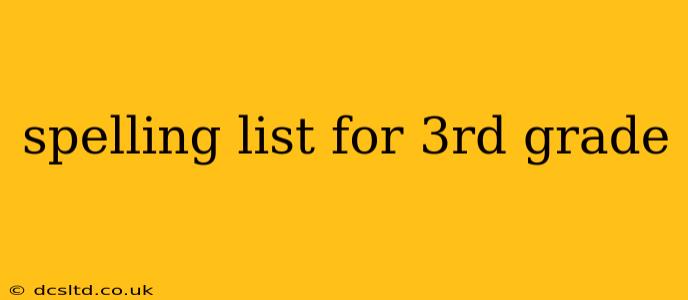Third grade marks a significant leap in spelling abilities. Students are moving beyond basic phonetic rules and encountering more complex word patterns, prefixes, suffixes, and silent letters. This guide provides a comprehensive approach to creating and using effective spelling lists for third graders, encompassing strategies for learning, practice, and assessment.
What Words Should Be on a 3rd Grade Spelling List?
Creating a robust spelling list requires careful consideration of the words' complexity and relevance to the curriculum. Here's a breakdown of word types commonly included in third-grade spelling lists:
-
High-Frequency Words: These are words frequently encountered in reading and writing, such as "because," "through," "though," and "their." Regular practice with these words solidifies reading fluency and writing accuracy.
-
Words with Common Prefixes and Suffixes: Introducing prefixes like un- (unhappy), re- (rewrite), and suffixes like -ing (playing), -ed (jumped), and -ly (quickly) expands vocabulary and spelling skills.
-
Words with Silent Letters: Words containing silent letters, like "know," "knife," and "wrong," challenge students to recognize spelling patterns that deviate from pronunciation.
-
Words with Vowel Teams and Diphthongs: Mastering vowel combinations (like "oa" in "boat," "ai" in "rain," "ee" in "tree," and "ou" in "house") and diphthongs (like "oi" in "oil" and "ow" in "cow") is crucial for accurate spelling.
-
Words with Common Spelling Patterns: Focusing on patterns like consonant blends (like "bl," "br," "cl," "cr," "dr," "fl," "fr," "gl," "gr," "pl," "pr," "sc," "sk," "sl," "sm," "sn," "sp," "st," "sw," "tr," "tw," "wh"), digraphs (like "sh," "ch," "th," "wh"), and trigraphs (like "scr," "str") helps students develop a deeper understanding of how letters combine to form words.
-
Words from Reading and Writing Assignments: Incorporating words directly from their reading material and writing assignments makes learning more relevant and engaging.
Strategies for Effective Spelling Instruction
1. Multi-Sensory Learning: Engage multiple senses to enhance memorization. Try these techniques:
- Visual: Use flashcards, word walls, or write words in different colors.
- Auditory: Say the word aloud, emphasizing syllables and sounds.
- Kinesthetic: Trace the word in the air or on sand, write it in large letters, or use play-dough to form the letters.
- Tactile: Use textured materials to trace the letters, or have students write the words on sandpaper.
2. Breaking Down Words: Teach students to break down complex words into smaller, manageable parts (syllables, prefixes, suffixes, root words). This strategy improves understanding and spelling accuracy.
3. Mnemonic Devices: Use memory aids like rhymes, acronyms, or visual imagery to help remember difficult spellings. For example, for "believe," you might remember "i before e, except after c."
4. Regular Practice: Consistent, short practice sessions are more effective than infrequent, lengthy ones.
5. Positive Reinforcement: Celebrate progress and effort to encourage students and build confidence.
6. Differentiated Instruction: Adapt the spelling lists and activities to cater to different learning styles and abilities.
Common 3rd Grade Spelling List Challenges: Addressing the "People Also Ask" Questions
Here are some common questions parents and teachers have regarding 3rd-grade spelling lists, and their answers:
Q: What are some common spelling mistakes 3rd graders make?
A: Common errors include confusing homophones (e.g., their, there, they're; your, you're), misusing vowel combinations, omitting silent letters, and struggling with prefixes and suffixes.
Q: How many words should be on a weekly spelling list?
A: A manageable list usually contains 10-15 words, allowing for focused learning and sufficient practice time. Adjust this number based on the student's individual needs and progress.
Q: How can I make spelling practice fun?
A: Incorporate games, such as Scrabble, Boggle, or word searches. Create spelling bingo, or have students write short stories using their spelling words.
Q: What if my child struggles with spelling?
A: Provide extra support through one-on-one tutoring, utilize assistive technology, and work with the teacher to identify the root cause of the difficulty. Explore different learning techniques and strategies to find what best helps your child.
Q: Are there any online resources to help with 3rd-grade spelling?
A: Many websites and apps offer interactive spelling games and practice exercises, catering to different learning styles. However, it's important to always supervise children's online activities and verify the safety and quality of any websites or apps before using them.
Conclusion
Creating and utilizing a well-structured third-grade spelling list is crucial for fostering accurate spelling and expanding vocabulary. By incorporating varied strategies, addressing common challenges, and providing consistent support, educators and parents can empower students to become confident and proficient spellers. Remember to focus on understanding and application, not just memorization.
